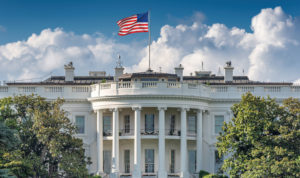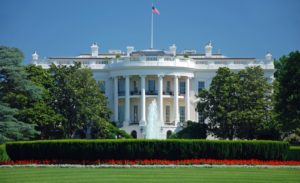
Scholars contend that the President may revoke monument designations made during previous administrations.
Near the end of his second term of office, President Barack Obama designated as national monuments more than 1.5 million acres of federal land in southeastern Utah and Nevada. But many Republican officials in Congress and in both states criticized these designations for placing too much land off limits for energy development and circumventing state and local stakeholders. Shortly after assuming office, President Donald Trump issued an executive order announcing he would consider rescinding these designations—and he did in fact later rescind them for some tracts of land.
But a President’s legal authority to modify or eliminate monument designations made by a predecessor is open to debate. In a forthcoming article, Todd F. Gaziano, of the Pacific Legal Foundation, and John Yoo, a professor at University of California, Berkeley School of Law, observe that legal scholars disagree about whether the President can “revoke a monument designated by his predecessor” under the Antiquities Act—the law on which President Obama relied in protecting the land in Utah and Nevada.
Gaziano and Yoo take the position that the President can revoke or scale back the size of monument designations made by past Presidents. In their view, Presidents have “a general discretionary revocation power” that necessarily accompanies presidential authority to designate monuments in the first place. Moreover, they contend that even if Presidents do not have a discretionary revocation power, they nonetheless have “a limited power to revoke monument designations” when circumstances change, for “factual error,” or if designations “were illegal from their inception.”
President Theodore Roosevelt signed the Antiquities Act into law in 1906. The statute responded to concerns about “preservation of America’s archeological sites and the artifacts.” According to the National Park Service, the Act provided “the first general legal protection of cultural and natural resources in the United States.”
But Gaziano and Yoo explain that “the creation of large scenic ‘parks’ was not the Antiquities Act’s purpose.” Rather, they contend that the Act aimed at protecting archeological sites. Illustrative of the Act’s focus on manmade objects, they argue, is its reference to “objects to be protected,” and of reserving lands on which “objects are situated.” Gaziano and Yoo concede that the Act’s “final language covered more than antiquities,” but they note that the Act nonetheless requires that monuments “be confined to the smallest area compatible with proper care and management of the objects to be protected.”
Executive Order 13,792—which President Trump signed in April 2017—directs Secretary of Interior Ryan Zinke to review monument designations “made since January 1, 1996, where the designation covers more than 100,000 acres.” In a June 2017 memorandum, Zinke recommended to the President that he modify the boundaries of the Bears Ears National Monument in southern Utah to make it more “consistent” with the intent behind the Antiquities Act.
Gaziano and Yoo rely on what they call a “general principle of constitutional and administrative law” that all governmental entities “can undo their past decisions by following the same legal process.” Article I of the Constitution does not specify the “process for repealing a statute,” they note, but it is understood that Congress may repeal a statute with a new law. Likewise, the U.S. Supreme Court occasionally repeals earlier decisions, as it did when it overturned Plessy v. Ferguson in Brown v. Board of Education. Passage of the 21st Amendment repealed the 18th Amendment, which established Prohibition. And federal regulatory agencies use the notice-and-comment rulemaking process to repeal previously adopted regulations.
Moreover, when it comes to presidential authority, it is well recognized that Presidents can reverse or modify prior executive orders, as illustrated by the series of executive orders addressing presidential review of agency regulations, beginning with President Gerald Ford’s Executive Order 11,821 and extending through President Trump’s Executive Order 13,771.
Even if the President does not have a general, discretionary power to revoke monument designations, Gaziano and Yoo argue that the President might still be able “to abolish some designations based on an earlier factual error, changed circumstances, or an original statutory violation.” For example, if a designation were intended to protect artifacts that are later “excavated and removed,” it would be difficult to argue that the monument is still “confined to the smallest area” possible.
Gaziano and Yoo also argue that a President could determine that “former monuments are illegally large relative to the original ‘object’ supposedly being protected” and should be scaled back to comply with the Antiquities Act’s “smallest area” requirement. Such a determination might even justify revoking the previous monument designation altogether, they suggest. For example, if there were no feasible way to bring the monument down to a legally permissible size, such as “by severing discrete parcels of land,” the President might be able to “declare that the initial designation was void” by relying on his duty under Article II of the Constitution to “take care that the laws be faithfully executed.”
Gaziano and Yoo concede that other legal scholars have taken the position “that a President cannot reverse or narrow” monument designations. For example, University of Colorado Law School professor Mark Squillace has argued that the power “to abolish or diminish national monuments” belongs to Congress. In support of this view, 121 law professors wrote a letter to Secretary Zinke in July 2017 arguing that Congress provided in the Antiquities Act only “a limited delegation” that allows the President to “reserve a monument, not to diminish or abolish one.”
Still, Gaziano and Yoo observe that legal scholars who argue the President may not reduce a monument’s size rely on a 1938 advisory opinion written by the then-U.S. Attorney General, Homer Cummings. The opinion advised President Franklin Roosevelt that he needed “clear authorization from Congress” to revoke a monument designation by President Calvin Coolidge. But Gaziano and Yoo counter that Cummings relied improperly on a still-earlier legal opinion authored by President Abraham Lincoln’s Attorney General, Edward Bates. Writing more than forty years before the Antiquities Act was enacted, Bates determined that President Lincoln “could not return a military reservation.” Gaziano and Yoo point out that, by the time Bates authored his opinion in 1862, “Congress had specifically repealed any statutes that authorized the sale or transfer of military sites to the public.” By contrast, monument designations under the Antiquities Act are not subject to any “express statutory prohibition on the presidential withdrawal of national monument status,” they say.
Gaziano and Yoo’s article appears in the Yale Journal on Regulation.



